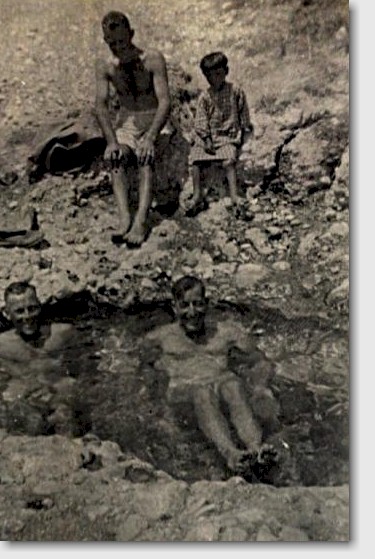
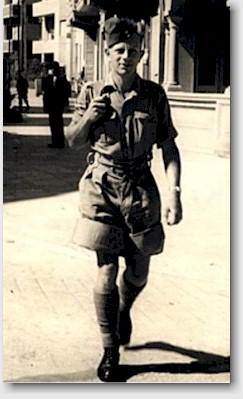 Memoirs of a Kiwi Soldier
during the Second World War
Memoirs of a Kiwi Soldier
during the Second World WarThoughts From Syria
Three Nights Out In A Truck
Qalaat Jaber: an ancient castle in North Syria
Crossing The Sangro
Diary recalls spectacle of Cassino attack
Audience By His Holiness, Pope Pius XII
Sun, heat, wind, and dust; calm sultriness; sudden whirlwind bursts of dust and straw; occasional huge rain-drops; shimmering heat in which trigs dance crazily and skylines ripple like shadows on the bottom of a pool. Sandfly fever, flapping tents, dust in your mouth; hot beer, scented lemonade, issue cigarettes and thirst; a roaring Hydra in the cookhouse, a sweating slushy washing up. Bully and prunes, onions and rice, porridge and eggs, herrings and carrots, watermelon and apricots,golden syrup, marmalade, fig and apricot, margarine like oil, butter like Heaven, happy - like Hell!
Broad river flats, rolling hills, gravelly wadis, dark cliffs, rocky heights, sunset and shadow, ancient tels, Hittite ruins, gleam of the dreaming Euphrates, sleeping villages, smoke hanging low, silence and peace.
Sparse, sweet grey sage, prickly bushes, green and blue, white flowers, thin wheat, stones and stone, gravel and stones, more stones.
Hills studded with stones, piled with cairns, graves of stones.
Lizards an inch long. Lizards a yard long. Asps, snakes, scorpions, spiders as big as your hand, centipedes, beetles and ants of all sizes, insects of many kinds. Turtles, moles, tortoises, grasshoppers with blue beneath, or red. F L I E S. Gazelle and foxes.
Birds as big as tuis, bright green or bright blue, crested skylarks, squawking partridges or quail, owls, huge buzzards, wild toi, like geese, birds green, blue, yellow and striped. Sparrows and swallows. Bats in the moonlight, dipping for drink.
Untidy villages, mud huts, square and domed. Flocks of sheep and goats. Piles of cut wheat. Cattle drawing discs round and round to cut wheat into chaff. Storage pits. Belligerent dogs, greyhound, St. Bemard, and dog. Women in long dresses and Bombay bloomers and top-heavy head-dresses dragging ropes to raise water from well; squeaking pulleys.
Inevitable welcome committee. Beards grey and black, clipped and straggling. Ragged kids, afraid to approach, reluctant to run. Gold teeth, blue enamel inlays. " Marrhaba !" and touch your forehead with thumb and forefinger. "Ana lazem moia kwaiss; inter lazem tenac ?" Cool drinks, full bottles. Invitation to dine. Whitewashed walls. Cool. Hard mud floors, woollen carpets, cushions.
Surprise - fireplace and chimney ! Smelly smoke - cow manure? Bitter
coffee. Coughed orders. Make yourself at home. Goat's milk - sour. Curds,, also sour. Not
too much of that. White butter, kobbas like sheets of paper. More coffee.
Strong cigarettes. Gallery of interested spectators. Scraps of awkward Arabic. Wide smiles, dish out some issue cigarettes, as far as they will go. Shake hands. Back to the track, mob follows. "Ma Salama." More mad joltings over donkey tracks like a railway junction.
Camels supercilious but nervous: dignified walk, ridiculous trot. Donkeys with white patches round nose and eyes. Appealing baby donks with huge cars and helpless air. Stupid cows, fine horses. Chickens and pigeons.
Pond at spring. Crystal water, 78 deg. Homicidal sprats, turtles, snakes, crabs. Just big enough to jump around in. Gendarmes' quarters twenty yards away. Shy women, almost unseen. Small girls who walked past with arm over face, but peeping.
Inevitable annoying gallery of Arabs, childishly curious about our unabashed nudity. Mad dogs who get right into cold water. Throw in the smallest Arab to see if it hurts. Tears and weeping. Laughter and many "Maleeshee's" Tentative solicitations for "cigara" or "tenack."
L.W.McBeath. Rass el Ain, Northern Syria.
17th April, 1942
18th July, 1942
Since we arrived here, we have been fully occupied putting up drums as trig points, ready for observing. Some of the country, especially ridges, is mighty rough and stony. We are further from the river now, so there is very little flat land. We see gazelle nearly every day, and toi. Dave Mitchell was with us yesterday and shot one toi.
They are very much like a light grey turkey, with a crest of long white feathers round the head and neck. Of course, they make good eating. There are some foxes around too.
On the way down the river today we saw a large citadel on the farther bank. It seemed in fairly good condition and should be worth exploring. Around this part the rocky banks near the road seem to have been quarried for huge blocks, possibly for the same citadel. A large cave could be seen in one bank with hundreds of pigeons perched around it.
At three-quarters of a mile from our first point the truck broke the steering rod - a habit of Fordsons. We were about fifteen miles from camp and Bombardiers White and McKechnie had to walk to the police post at Sirrine for help. It was about six miles away. Help and my bedding arrived at dark. Alan Bell was driving, and he and I were to stay with the truck until a new part arrived from Aleppo. The 3-tonner arriving at dusk missed us and we had quite a good time with petrol fires attracting their attention. When they arrived we boiled up and had tea. White and McKechnie turned up again about 10 o'clock, and there were quite a few recriminations and explanations flying round because they had been missed too. We finally got to bed about 11, Bell and I, after the others had gone back to camp.
The Arabs started to arrive at 5 o'clock in the morning and before long there were 25 of them. They had seen the fires the night before. They went over the ground like a fine tooth comb to see what they could find. We bargained for eggs and before the day was out had three and a half dozen. Henceforth,, our diet was eggs. Half of them had chickens inside, but the vendor never came back.
We stood guard alternatively through the night and had our rifles handy. Allan heard someone on Sunday night at about 11 o'clock and turned the lights on him, but he hooked it pretty quick. On Monday night some Bedouins got stuck into the village of Sohrij, and rifles were going off in good style. This was only half a mile away, so we were on the 'qui vive' properly. When the boys turned up with the spare rod on Tuesday, we were pretty sick of it and glad to get back to the camp.
There was a letter from England for me, Auntie Ruth still going strong. Had two letters from Mary; there should be more somewhere.
Conditions for writing are not too good here. We are usually out until 7 or 8, and ready for bed by 9. The heat is pretty bad, and none of us feels fit at all. We are pretty fed up with the place. If it's not the sun, it's the wind, or the flies, or the natives. In short, we are browned off. However we had our Patriotic parcels last week. Tinned fruit and chocolate go all right if they can be cooled off.
Eleven days later a party of us left to spend the weekend
at Ain Arouss. We camped on real grass on the edge of the lake and spent most of the time
either in the swimming pool or on the bank. Some of the boys took their rifles along the
shore and shot enough fish for two meals. The water is alive with fish from tiny tiddlers
to good ones about two feet long. There are some few also, much bigger than that, up to
five feet long - real monsters, but only two of us saw one, as they seem to lie low in the
reeds.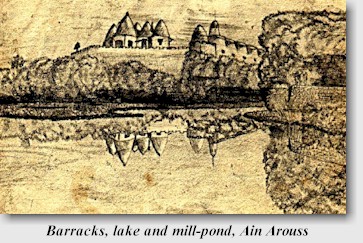
In the evening there are some fine reflections in the water, and I took a sketch from the camp site, looking towards the military barracks, with the walled-up pool (actually a mill-pond) on the right.
The town is full of Armenians, and their European-style dress makes a pleasant contrast with that of the Arabs.
It was a most pleasant weekend, sleeping on the grass under the trees, with the water so close and the moon nearly full. We managed to get some arac too, which is a very good drink when diluted enough. In its raw state it must be about 90% alcohol and 10% aniseed; anyway, it is one of the most potent brews obtainable.
(On a later occasion!) Allan Bell: "I keep looking at you, Robbie, and wondering when rigor mortis is going to set in!"Aracinactivity:
Mick Chisholm went to sleep in the corner of the truck, and he was dropped off the back. Today he wants to know why the party was not held on top of the Eiffel Tower.
Jim Batty ("Gee Aus Your boys are doing great up in the Desert!") "These were supposed to be fritters but they turned out to be rissoles, and they taste like sausages."
L. W. McBeath.
Ras el Ain, Northern Syria.
20 August, 1942
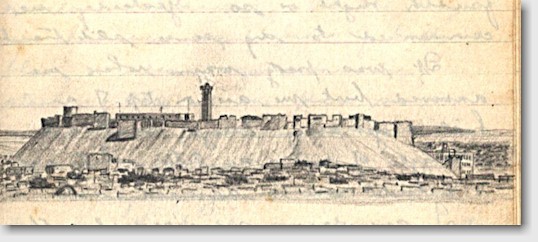
An ancient castle in North Syria.
28th September, 1942.
Yesterday morning we broke camp and moved to this area 20 or 30 miles North-West of Rakka. We made camp on the Euphrates River flats some hundreds of yards from the water, alongside an ancient ruined castle, built by Turks, probably. Half a mile away is a small fenced area containing a very old tomb and a small cottage housing a guard, and flying the flag of Turkey, red, with white crescent and star. Yesterday the wind was South Easterly and blew up a beautiful dust storm. Our eyes were full of dust and made us feel very miserable. Today it has returned to the prevailing westerly, and all the dust is coming back again. And today, too, I have been dipping into the 16th century. Alan Bell and I have been up to see the castle.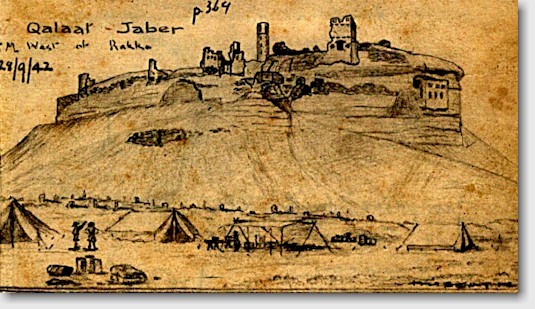
Qalaat Jaber ancient muslim castle in Syria - pencil sketch
Long before we reached the slopes we could hear the wind gushing through the gaping doorways and broken brickwork. Birds hung motionless, with wings almost closed, just above the decayed walls. Not far up the slope is the great hollow of the moat, and from the farther bank the solid rock and broken brick walls and shattered towers rise vertically for a hundred feet and more. The moat around the Southern quadrant has fallen away. Sundry arches and rough walls stand confusedly at the South-West extremity of the castle, and from here a couple of small archways lead into a large tunnel which slopes upwards into the open spaces above. Rock, decayed into blue flour, strange shapes of red brick, dark holes full of rushing wind, give an eerie effect. The open space above is one confused mess of fallen bricks.
The castle has been built on an oval rock. Walls of burnt bricks, flat and square in shape and as hard as our own, with towers, round and polygon, were constructed as defence works around the top, in continuation of the steep rocks. A moat surrounded it, but how it was filled I don’t know, for although one ancient canal runs down towards it, the moat is so much higher that it could not be very well supplied from that canal. (Later: Races in Otago take water long distances at well maintained height, by closely following the level contours of the land, and on the previous day we had seen, about 20 miles up-river, the remains of a large, ancient canal, which might well have been the means. Anyway, it became apparent that the moat was the sewer treatment area, and did not need clean water!)
On top, in the center of the castle, stands a huge tower, 100 feet high, round, 12 – 15 feet in diameter, on a square base about 20 feet high. A doorway 20 feet up shows a circular staircase running up inside. The building has a noticeable lean, and has been patched recently. The mortar between bricks is much like our own, but is now rotten. In stonework however, it is more like cement, grey in colour, and harder than the stone.
Everywhere amongst the debris are scraps of pottery, glazed fragments of plates or jars, pieces of unglazed gourds. Here a piece of shattered glass, shining in irridescent colours; there a fragment of glazed clay, red or blue, or yellow or green, patterned in lines or blobs of black, purple or brown; perhaps black in colour, shining like opal. What love lay behind the making of this shining piece of black bangle, or what vanity its purchase?
Up there are traces of a big fire, pieces of fused brick and stone. Was it a furnace? Or conquest, destruction and devastation? Just enough to make us wonder, to peer into the dim recesses, seeing only unformed shadows, imagination of the shades of those times. The wind was fierce. It roared round shattered ends of walls, through decaying windows. Small unseen particles stung my face.
Back above the entrance is half a room. A chamber - high domed ceiling, plastered smooth and white, but stained now with wet; and dusty, flaked with age. A little beyond, a deep hole, perhaps a subsidence of one of the tunnels, several of which lead off near the main entrance. Further around, a watch-post, clinging oyster-like to the perpendicular wall.
Wonderful view. Flat green fields of hashish. Sundry Bedouin camps. Tiny fluttering tents just below – ours. The sprawling silver of the aimless river. Dusty barren hills, wrinkled with age, shining white with patches of gypsum. Nearer, the thick pock-marks of excavated cemeteries and black eyes of caves. I went down for a look. The graves seemed to have been excavated systematically, about two feet deep. As there were no scraps of pottery about, I guessed it had been done by archaeologists. The caves were hand-hewn and made quite large chambers, half-full of water-washed dust.
The French map records the nearby guarded tomb as that of one Slaimāne. The Ottoman Turkish empire was at its height at the death of Suleiman (the Magnificent) in 1566. This tomb is several hundreds of years old, and I believe must be the tomb of this same Suleiman. Perhaps the castle was his. I may be able to find out.
"SANTA Maria? Thought it was "AVE Maria!"
2nd December, 1943.
On Thursday we moved off independently to go across the Sangro. We had instructions to cross the river and take the first road to the right, where we would find Golding waiting for us. At the river, the M.P.s told us where the first bridge was. We thought it was a long way down, but the M.P.s assured us there were none further upstream, so we proceeded. There was no turn to the right and we continued across the wide flat valley floor, up the olive-covered slopes on the other side and through a battered village. All the way up the slopes, the ground was pitted with shell holes. Groups of twos and threes were touching, most were about six feet apart. There were occasional dead mules, blown to pieces, and in one place, about a dozen piled up. On one corner in the town was a burned-out Mark IV tank in a bad mess, with a ticket on it to say it was "got" with a PIAT gun – a new development.
On past the village, we came on two more knocked-out Mark IVs, and shortly afterwards decided that we had gone much further than we were expected to, so we got out to talk it over. A small village was away about 300 yards to our left. There were large bomb craters here and there. We thought how nice it was that Jerry had had all that amount of shaking up.
Well, I had just lit my cigarette when ‘THEY’ were coming down on us. I didn’t bother to count them. I danced across five yards of ploughed soil (who knows how many mines were in it?). Jo disappeared somewhere. The Saint dived into a three-inch furrow with a Tommy. Jack found a place between a Jeep and a bank. I stood and watched where the planes were going. Those I saw first were all right, but then I spotted three more coming our way. I got down. Then the machine guns began. It was a shock – I had not thought of them. Then wham! wham!, very close. A buzzing whiz coming – wham! I presently looked up to see where things were. The earth was still going up. What goes up comes down. My head went down again too! Over came more. More bombs and machine guns. Puffs of concussion, spattering of earth. Could easily feel the shots hitting the ground around us; hear them, too.
Three bombs around us, within forty yards and a machine gun bullet through the door of the truck. We got up and grinned.
The two Tommies had left their bikes on the road. On of them had his ear skinned, and a bit in his chin. That was the one next to the Saint. I was feeling as good as gold. In a few minutes, everyone appeared. A couple of hundred yards back down the road, a three-tonner, loaded with ammunition, was blazing, and popping merrily. This was the Saint’s first action, and he took it quite well. Jack was pretty excited and wanted to turn around and go back home. Nobody stopped him, but we had not gone far when we saw it would be foolish to pass the fire. We waited, but it did not die down.
A brigadier went along in a jeep, and after a bit, bypassed the burning truck. We decided to give it a go. One side of the road was soft ploughing, the other side was soft ploughing plus large bomb holes. We got twenty feet, and spent a quarter-hour getting back again. We did not have four-wheel drive.
It was now that I began to think of the half-hour intervals between raids, which we had noticed in the distance some time before and which, we were now certain, had been directed at this village. Presently the bloke in the bulldozer repairing the road took his machine up to the fire, blade up high for protection against the explosions, then lowered it and pushed the vehicle off the road. It was a bit of good work. We clambered in and sailed back down to the river. During our wait we had spoken to a Tommy officer who told us there were no Kiwis in this sector, so it became our intention to recross the river, and start again when we saw some Kiwis.
At the river we were blocked by an artillery regiment coming over, and
were forced to wait at the head of a rapidly-growing column of closely-packed trucks. We
began to think of the planes again. Over they came, fifteen of them, down on the same
village again. Jack and the Saint were dithering a bit. They wanted to get out of the
place, but we were jammed back and front, and couldn’t even turn. So I made up their
minds for them. "When in doubt, brew up!" is an old slogan now. We got out the
things and had our lunch. A very pleasant Tommy officer passing took an interest in our
‘Thermette’ and stopped for a yarn. He liked pickles, and was not too proud to
scrounge some. He got some beef and cocoa, too.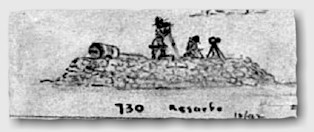
Soon after we had finished, we were able to move on. We recrossed the Sangro and back-tracked til we found our bridge, and were jammed again for nearly an hour. We learned that Jerry came over each day to go the bridge between three and four o’clock. It was now two p.m. and we did not expect to get away for an hour. However we did, without incident, and soon found Goldie, and subsequently, our billet.
In the days following, everyone seemed to have heard of our adventure. Someone asked us the name of the village. The Saint replied: "Santa Maria." "And," said the bloke, "I suppose you thought it was a case of ‘Ave Maria!’"
Army Service, L.W.McB. 1940-45.
‘Asimuth in Italia’, p. 52, 2.12.43.
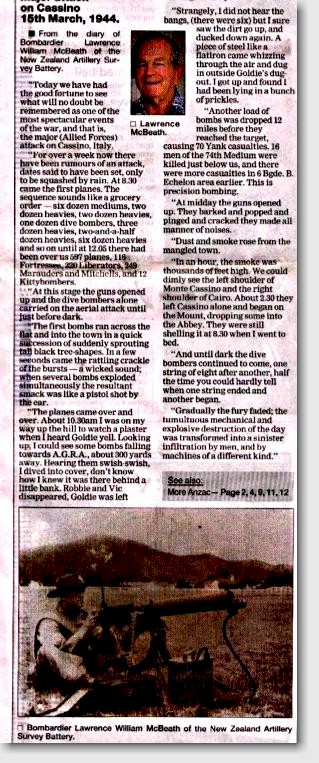 From the front page of the Northern Advocate, Saturday April
24th 2003:
Special Feature: Memories of
a World at War
Diary recalls spectacle of
Cassino attack
From the front page of the Northern Advocate, Saturday April
24th 2003:
Special Feature: Memories of
a World at War
Diary recalls spectacle of
Cassino attack
MAJOR ATTACK ON CASSINO
15th March,1944
Today we have had the good fortune to see what will no doubt be remembered as one of the most spectacular events of the war, and that is, the major attack on Cassino.
For over a week now there have been rumours of an attack, dates said to have been set, only to be squashed by rain. Yesterday and the two days before have been very fine, and this morning there was not a cloud in the sky, and not a breath of wind until a faint breeze rose about 9.30.
At 8.30 came the first planes. The sequence sounds like a grocery order – six dozen mediums, two dozen heavies, two dozen heavies, one dozen dive bombers, three dozen heavies, two-and-a-half dozen heavies, six dozen heavies and so on until at 12.05 there had been over us 597 planes – 116 Fortresses, 220 Liberators, 249 Marauders and Mitchells, and 12 Kittybombers. At this stage the guns opened up and the dive bombers alone carried on the aerial attack until just before dark.
The first bombs ran across the flat and into the town in a quick succession of suddenly sprouting tall black tree-shapes. In a few seconds came the rattling crackle of the bursts -a wicked sound; when several bombs exploded simultaneously the resultant smack was like a pistol shot by the ear.
The planes came over and over. The black tree-shapes sprouted and grew, billowed into a black haze so that half the time we could not see even the flash of the bombs. We could see the streams of them fall from the planes; the air seemed full of bombs and planes. We watched a stick of twelve bombs fall on our 6 Brigade B. Echelon.
About 10.30 I was on my way up the hill to watch a plaster when I heard Goldie yell. Looking up, I could see some bombs falling towards A.G.R.A., about 300 yards away. Hearing them swish-swish I dived into cover – don’t know how I knew it was there – behind a little bank. Robbie and Vic. disappeared, Goldie was left holding a tree up. Strangely, I did not hear the bangs, (there were six) but I sure saw the dirt go up, and ducked down again. A piece of steel like a flatiron came whizzing through the air and dug in outside Goldie’s dug-out. Presently I heard running footsteps, and voices saying
"- - - - this! The dug-out for me!" I got up and found I had been lying in a bunch of prickles.
It can be imagined that we were very chary about planes that came too close overhead after that display, and the glasses were on them from the time they appeared. Another load of bombs was dropped twelve miles before they reached the target, causing 70 Yank casualties. 16 men of the 74th Medium were killed just below us, and there were more casualties in 6 Bgde. B. Echelon area earlier. This is ‘precision bombing.’
The shadows of sound waves, seen in the sky and against high cloud, as I have mentioned on another occasion, were working so hard today that they seemed almost a shimmer, jazzing at all angles in all directions, but visible only against patches of very high cirrus cloud, or vapour trails.
At midday the guns opened up. They barked and popped and pinged and cracked – they made all manner of noises. The hills caused strange effects. The gun would go off, there’d be silence for a few seconds, then the echoes would begin to roll and roar around the valleys. Sometimes they sounded like a diving plane. Sometimes we’d not hear the gun, just a light thud, and then the shell going over, saying "Swish-ish-ish-ish - - -Whe’sh ya bivvy? Whe’sh ya bivvy?"
Dust and smoke rose from the mangled town. In a quarter of an hour, if we held an open hand at arm’s length, palm towards us, the width of the hand would not cover the murk. At a range of 4 1/2miles, that’s a good indication. In an hour, the smoke was thousands of feet high. We could dimly see the left shoulder of Montecassino and the right shoulder of Cairo. About 2.30 they left Cassino alone and began on the Mount, dropping some into the Abbey. They were still shelling it at 8.30 when I went to bed.
And until dark the dive bombers continued to come –
one string of eight after another, half the time you could hardly tell when one string ended and another began. The air held lots of fighters. The bombers were very lightly escorted and three German fighters came over during the morning. We heard planes diving and m.g’s. going, and a Lightning went away smoking, whether hit or not I don’t know. A large square object, perhaps a bomb door, came tumbling out of an apparently empty sky shortly after, and landed over the hill somewhere. The Messerschmidts went off, chased by Yank A.A.- Yank A.A. is excellent. Desultory fire from 88’s followed some of the heavies as they passed over the German lines on the way home.
Gradually the fury faded; the tumultuous mechanical and explosive destruction of the day was transformed into a sinister infiltration by men, and by machines of a different kind.
L.W.McBeath, Cassino, Italy.
POPE PIUS XII,
AT VATICAN CITY, 20th JUNE, 1944,
-----------------------------
Written by L W.McBeath at that time.
Arce, Southern Italy, Wednesday, 21st June, 1944. Yesterday morning, got up at 3.30 to go to Rome. Left camp at 4.30, Div. Arty. at 5.30. I was riding on the spare, behind the cab, where I could get a good view, but unfortunately it was a very foggy morning and we could not see far. It is 80 miles roughly from here to Rome, and in that distance there are over 120 wrecked German vehicles, guns and tanks and numerous Hun graves, all of which makes very good scenery indeed.
Both Frosinone and Valmontone are badly knocked about. Around Valmontone there are numerous caves in the cliffs where families live in good cover. The country, when the fog lifted, was fairly flat and I was surprised to see that Rome, The City of the Seven Hills, is not very hilly at all.
We reached the city at about 9.45. The car-park is in the South-East corner, only a mile or so from the point where Highway 6 entered the city, but we had to follow directions right up through the centre of the city and down the Tiber(River) to the car-park (about 4 miles.) Of course this was welcome from the point of view of sightseers. After finding the car-park, the truck proceeded back to the church of Santa Maria di Angelist, where a special thanksgiving service was held for R.C’s. of Eighth Army. Those attending were to be received in audience by His Holiness the Pope at Vatican City. Tom Thorpe and I had a look at the church and the service, but we could not hear, and so proceeded to have lunch instead. This cathedral is very big and beautiful. Many artificial candles looked like stars all around the altar in the dim interior.
We reached St. Peter’s at about 11.45. A very wide street approaches the cathedral, affording a splendid view.
When I reached the temporary wooden barrier, I could see simply a large cathedral on the other side of the wide , open piazza, which was almost encircled by a huge colonnade. In the centre is a tall obelisk. Flanking it are two fountains, in which the water appears to fall very slowly, until, on a second look, it is seen that the fountains are a good thirty feet high. After about ten minutes walk we reached the other side and began to realise that the place was fairly big all right.
We entered a corridor – a hall rather – which sloped uphill, and at the other end, a good 200 yards, was a crowd of diminutive looking soldiers on their way to see the Pope. The press resolved itself into a scrum before we reached the top, where, as we passed in, we were handed a small silver plaque and a small picture, each of the Pope. (My late recollection is that the plaque – badge – bore on the reverse an image of St. Christopher, the patron saint of travellers.)
The reception hall was a long, lofty hall running across the front of the cathedral. Down the length of it were two barriers about 12 feet apart, forming a gangway along which everybody pressed to see the Pope as he passed. At the far end was the throne, on a raised dais. Officers and nurses took their places there. Swiss guards in blue and scarlet livery were very picturesque.
After half an hour or so the procession came in, halberdiers, cardinals, and the Pope born in a chair, shoulder high. The entry of the party was the signal for prolonged cheering, and as they went past the Pope smiled and gave the sign of the cross.
He is a small, spare man wearing a tight scull cap and glasses. He has dark eyes and a very pleasant smile. He addressed the gathering for only about five minutes, in good but not perfect English. After his address and blessing, the officers and servicewomen kissed the ring on his finger – looked like a large onyx – and after a short time the procession came out again. This time, all those within reach raised their hands to be touched.
We descended by a different route and went into the cathedral. It is a vast place and it takes some time to gain any real conception of its size, for all the statuary is two or three times life-size. Of course it is all marble and gilt inside, but there are not the enamelled images seen so plentifully in the normal run of churches. All the statues are magnificent, and of many types of marble. Great drapes of carved and polished marble look from a few feet away, to be of real cloth.
Right under the main dome is the tomb of St. Peter surrounded by hundreds of oil lamps. It is surmounted by a huge canopy supported by four twisted and fluted black and gilt pillars
Far above is the dome, encircled with latin words in large gilt letters, and decorated with paintings of the heads of cherubs. Presently I could see the fine railing of a balcony running round the dome, and then picked out several people, tiny figures, walking round.
We were presently there ourselves after paying 15 lire entrance and climbing an interminable spiral staircase which led to the roof of the main building. Here was a mass of crazy gables running all ways. We found the figures along the front to be really huge, and the balustrade was too high for me to look over. There was a shop on the roof – a pretty large one, selling souvenirs.
We entered a door and in a few moments were standing on the gallery round the dome. The people below looked like ants on a polished floor. The ‘paintings’ of cherubs turned out to be mosaics about ten feet across, of many-coloured chips.
Another staircase, one-way, led us towards the top of the dome, inclining as it climbed til we were obliged to lean on the inner wall for support, until it resolved into a zig-zag up over the top. We came outside on to a gallery running around the cupola, from which there is an unsurpassed view of the whole city. We spent some time looking at it before returning, picking out points of interest from the map lent to us by the Major. The dome is nearly 300 feet high, and the tiny ball at the very top can accommodate ten men.
Getting back to the town, we looked up the new (N.Z) Club, not yet open. Y.M.C.A. were providing tea at the side, and we sat there for about an hour, drinking steadily, for it is a long, hot walk from the cathedral. Then dodging out again we went down past the Pantheon to the river (Tiber) and back again. The Pantheon was closed, so we drifted down through the Forum to the Colosseum and so back to the car-park.. The Colosseum is big, no doubt, but not so impressive. It makes a difference to have someone to tell what is what, and some of the history of the places.
The trip home was pretty crook. I had to sit hunched up in the middle of the floor, with no back-rest and only one place to put my feet, for four hours, and it was grim.
We got home about 3 a.m. and proceeded to boil up (a cup of tea.)
L.W. McBeath in Cassino, May 2004
For further information or to forward a message to Mac, please leave a message here